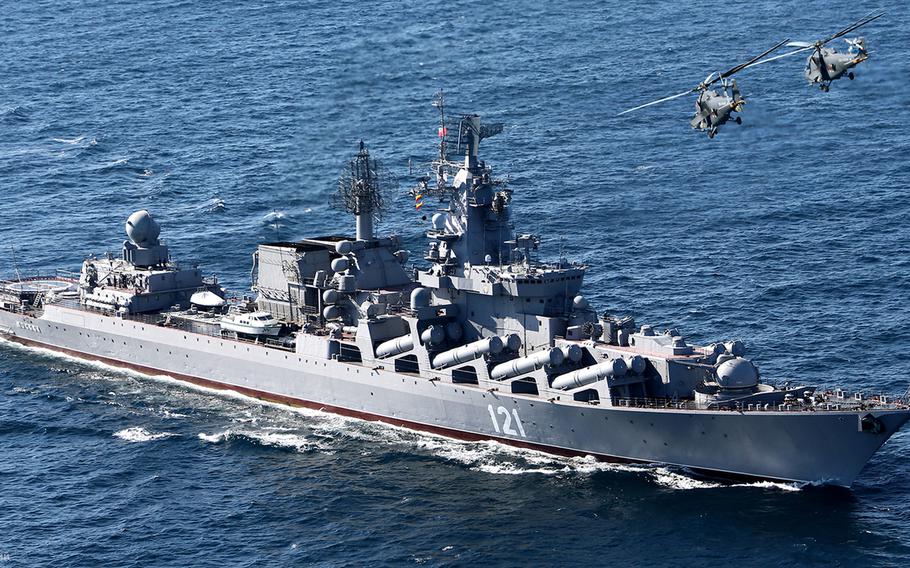
The Russian cruiser Moskva. (Mil.ru)
The sinking of the Russian Black Sea flagship Moskva on April 14 was the first destruction of a major warship in combat since the Falklands war 40 years ago, when both the U.K. and Argentina lost large surface ships in the cold waters of the South Atlantic. For the Russians, you would have to go back to World War II to find a comparable loss.
How will this dramatic event affect the war in Ukraine? And what are the lessons for navies worldwide?
I have toured Russian ships on several occasions (including in Sevastopol before the Russian invasion), and the surface ships produced in the 1970s and 1980s, like the Slava-class Moskva, have several weaknesses in construction and manning.
The most noticeable deficiency is a lack of the sort of combat compartmentation built into U.S. and other Western warships. Instead of multiple watertight doors that can be slammed shut when a ship is at general quarters (all hands manning their battle stations), Russian ships have little ability to divide up internally - making them far more vulnerable to what is called “progressive flooding,” a euphemism for sinking.
Another key shortcoming, which surprised me, is the lack of a strong corps of mid-grade professionals in the Russian navy crews. Called chief petty officers in the U.S. Navy, these are sailors with 10-15 years of seagoing experience who lead the sailors on the deck. They are the backbone of the U.S. Navy, and the absence of such a cadre is a major problem for the Russians. (The same weakness - a lack of strong noncommissioned officers - exists in the Russian land forces, a major factor in the problems they are encountering ashore since the Feb. 24 invasion.)
I recently compared notes on the Ukraine sea war with a retired U.S. surface-warfare captain. He reminded me that when he toured a Russian cruiser, the officers wore name tags on their uniforms, while the sailors wore only numbers. This mentality - a reminder that the Russian fleet is in part composed of conscripts - reflects a lack of a coherent chain of command. That can work in peacetime operations, but quickly breaks down in combat.
In the case of the Moskva, we don’t have the accurate reporting to fully evaluate the failures, but a couple of points stand out.
Most obviously, the readiness of the ship to defend itself from two incoming Ukrainian Neptune cruise missiles (now confirmed by U.S. intelligence) was flawed. Whether that stemmed from a lax “watch standing” - meaning the sailors weren’t at proper battle stations - or that the ship’s anti-air defenses were technologically insufficient, we may never know. In all likelihood, it was a combination of both.
Additionally, the ability of the ship to take a punch and keep itself afloat, called “damage control” in U.S Navy parlance, was obviously lacking. On an American warship, the crew is organized at battle stations into teams spread throughout the ship that are trained, equipped and prepared to respond to fires, flooding, loss of electrical power and other challenges. It appears the Moskva crew not only failed to blunt the incoming attack but could not control the combination of fires and flooding that followed.
The loss of Moskva is a gut punch to the Russian military and the Kremlin. First is the symbolic blow: The ship is named for Russia’s capital - think about the hit to morale and prestige you’d have if the U.S. lost the aircraft carrier George Washington.
The Moskva was also a capable command-and-control node to direct the rest of the Black Sea Fleet, which was thought to have been preparing for an attack or amphibious assault around the critical Ukrainian seaport of Odessa. Finally, its long-range cruise missiles were knocked out of action.
While the loss of a single ship is not in itself catastrophic, it is a considerable setback, especially given the warning signal it sends to other Russian surface combatants. Having now lost two significant warships (a tank landing ship was destroyed in port several weeks ago), the Russian navy will be doubly cautious in approaching the Ukrainian seacoast.
Finally, the sinking will have an effect on global operations of all navies. It is a stark reminder of the vulnerability of surface ships - including aircraft carriers, the heart of the U.S. Navy - to relatively low-cost, numerous and technologically advanced cruise missiles. As the Ukrainians have demonstrated by striking tanks, armored personnel carriers and helicopters ashore, the cost-benefit of a cruise missile kill is very high for the attacking force.
Both the U.K. and Argentina learned a lesson about ships’ defensive flaws in the Falklands - the British lost two destroyers and the Argentines fared worse. But for the two decades of the so-called forever wars, Western navies operated with impunity, projecting power ashore at will because Afghans, Iraqis and Syrians did not have Neptune-style cruise missiles. That won’t be the case in great-power conflict.
The death of the Moskva is a vivid reminder of the need for capable anti-air weapons systems, well-honed damage control and tactical choices when operating near hostile coasts. Even as Russia seeks to learn the lessons of the sinking of its Black Sea flagship, the U.S. and its powerful allies need to as well.
This column does not necessarily reflect the opinion of the editorial board or Bloomberg LP and its owners. James Stavridis is a Bloomberg Opinion columnist. He is a retired U.S. Navy admiral and former supreme allied commander of NATO, and dean emeritus of the Fletcher School of Law and Diplomacy at Tufts University. He is also chair of the board of the Rockefeller Foundation and vice chairman of Global Affairs at the Carlyle Group. His latest book is “2034: A Novel of the Next World War.”